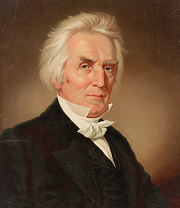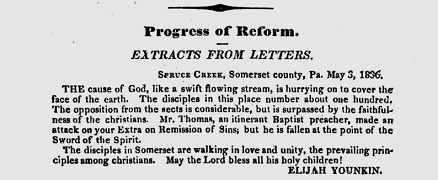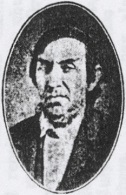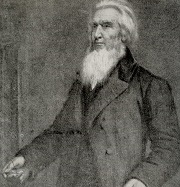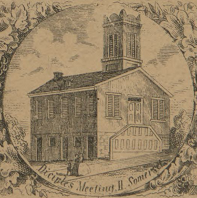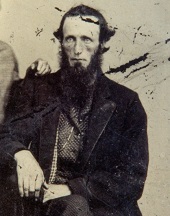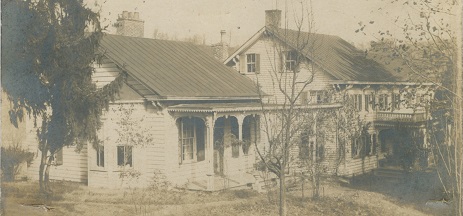
|
A Family’s Influence in Founding the Disciples of Christ Movement in Somerset County, PA |
| Detailed Map of the Upper Turkeyfoot Site |
|
By Mark A. Miner |
|
|
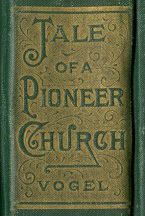 |
Vogel's book |
When my great-great-great-great grandfather, Jacob Minerd Jr., wrote his last will and testament in Kingwood, Somerset County, PA in 1842, the same year he was crushed by a falling tree and died, he requested his wife Catherine (Younkin) Minerd to inter his remains in the burying ground of the Christian Church in Turkeyfoot, according to its "rites and ceremonies." He also wrote in the document, “I earnestly entreat my wife’s utmost care respectively in and about the morals and education of my children … and desire that they be brought up and instructed in the doctrine and religion of the Christian Church."
So what was so special about the Christian Church in Turkeyfoot? This very question was one of the burning reasons I made my first trip to Kingwood in about 1978, when I was 17 years of age.
The congregation’s history has been largely obscured by the misty haze of the past, and paper trail is very slim. After many years of off-and-on research, I was amazed when studying Peter Vogel’s 1887 book, Tale of a Pioneer Church, outlining how this little country church played a part in the founding of one of our nation’s leading denominations, the Church of Christ, and how many of our extended cousins were involved in some way.
The denomination also has been known over the years as the “Disciples of Christ” – the “Campbellites” – and the “Christian Church,” all part of the “Reformation Movement."
|
|
The story starts in the late 1820s with Scotch-Irish immigrant Rev. Alexander Campbell, who with his father Thomas and brother Archibald became disenchanted with their Redstone Baptist Association, which blocked their efforts at reforming worship practices not based in scripture. Vogel writes that the Redstone Association “seems to have been a kingdom divided against itself.” Among Campbell’s complaints were the Baptists’ practice of rituals not specifically called for in biblical teachings, and the need for more reliance on scripture itself.
Campbell initiated discussions with other congregations expelled by
the Redstone Association, and then reached out to other churches in the
region, among them the historic Turkeyfoot Baptist Church in Ursina,
Somerset County, PA, familiarly known as the Jersey Church. On Sept.
7-9, 1827, Campbell met with a number of Somerset County
representatives, among them Dr. Jonas Younkin, to begin to map out a novel plan for a shared future.
The 1827 date is the only known one where Campbell actually traveled to Somerset County. His father Thomas and brother Archibald seem to have been there more.
In June 1829, Campbell’s father and brother visited the county seat of Somerset where they “preached a few times” and then went to Turkeyfoot “to work up interest in the Jersey church.” Then in September of that year, a reorganization of the movement was put in place in Somerset, with election of officers and charter membership, among them Dr. Younkin and his wife Martha (Prinkey) Younkin.
 |
Some of the names of the early Disciples leaders are familiar in the family – Chauncey Forward, a former congressman who resigned to become Somerset County register of wills and part-time evangelist, for whom Chauncey F. Minor (born 1840, the year after Forward died) may have been named – Rev. William Shadrack, a clergyman, who likely was the namesake of William “Shedrick” Younkin (born in 1838, when Shadrack was active locally) – and Aaron Schrock (Dr. Younkin's brother in law and the namesake of Dr. Younkin’s son Aaron Schrock Younkin born in 1845).
Forward established the Turkeyfoot church near Kingwood in the fall of 1831 or spring of 1832. Vogel describes the location as “about four miles southwest of New Centerville (fourteen miles in the same direction from Somerset) and known as Turkey-Foot, or Spruce Creek.” Among others, charter members included Dr. and Mrs. Younkin, Leonard and Martha (Minerd) Harbaugh Sr., Joseph Harbaugh and newlyweds Rev. Harmon and Rachel (Younkin) Husband.
Writes Vogel: "Dr. Jonas Younkin and Harmon Husband could preach pretty well. Forward visited them as often as he could, and so did Wm. H. Postlethwaite. Most of the evangelists that came to Somerset also took in Turkey-Foot…. They met for awhile in a shabby log school-house on the Turkey-Foot road. Afterwards they built a log meeting-house, which is now occupied by the German Baptists (Dunkards)."
During that period of Christian gathering, Elijah Younkin wrote about the group in a letter to Campbell, which was published in the church’s national Millennial Harbinger newspaper (edition of May 3, 1836), saying:
The cause of God, like a swift-flowing stream, is hurrying on to cover the earth. The disciples in this place number about one hundred. The opposition from the sects is considerable, but is surpassed by the faithfulness of the Christians. Mr. Thomas, an itinerant Baptist preacher, made an attack on your Extra no Remission of Sins; but he is fallen at the point of the Sword of the Spirit. The disciples in Somerset are walking in love and unity -- the prevailing principles among Christians. May the Lord bless all His holy children.
|
The Millennial Harbinger, Vol. VII, 1836. Courtesy Google Books. |
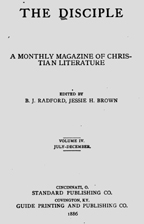 |
The Disciple, 1887 |
One of the cousins ran afoul of church governors and stringent rules in the mid-1820s. Vogel writes in his book about punishments which had to be meted out to parishioners from time to time: “A stray line alludes to some church troubles in 1823 that broke out afresh in 1826, and then lasted about a year,” he says. “But the demon Drink always works such wicked havoc that it is still clearly remembered that Wm. Philson, Abram Younkin and Dr. Bruce, had to be frequently disciplined for drunkenness, and that their copious tears of penitence were never wholly able to wash this stain out of their natures.”
In 1834, a new Disciples congregation was planted in Milford Township, with 23 members, several of whom formerly had belonged to the Methodist church. When “brother Younkin” preached to the Milford congregation, an old woman in the audience stepped forward and asked to be baptized, saying that “she had been a praying woman for upwards of forty years, and a member of the Methodist church – but as the Lord required her to be baptized for the remission of her sins, she was resolved to obey Him.”
David Younkin of Milford Township was one of those fortunate to have been baptized by Forward and was a great admirer. Some 53 years after his immersion, David wrote: “That good man, had he lived, I have no doubt, would have revolutionized this whole country."
Wesley Lanphear and John Henry are known to have conducted a preaching tour at the Turkeyfoot church on Oct. 27 and 28, 1840.
|
Christian Church in Turkeyfoot site, now only a cemetery, 1978. The brown patch at left center marks where the Brethren church once stood. Photo by Odger Wayne Miner
|
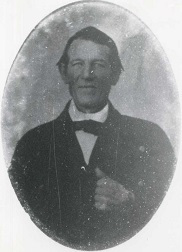 |
David Younkin |
Rev. Charles Louis Loos, who had moved to Somerset in 1850, preached at Turkeyfoot as well as at Berlin and Shade and, on rarer occasions, Laurel Hill, Stoystown and New Centerville. He once wrote that “Outside of the town [of Somerset] I frequently preached in German. I found a very cordial reception among the ‘German brethren.’ I preached among them a good deal – in every one of the meeting-houses in the county but one…. My preaching at the other points in the county, as at Berlin, Turkeyfoot, etc., was principally at the good will of the church at Somerset. These places paid something, but by no means for the full proportion of my time. My going to these stations was an act of generosity, largely on the part of the Somerset brethren.”
|
Rev. Harmon Husband |
As with many new institutions led by dynamic leaders, interest waned after these leaders eventually departed. Rev. Harmon Husband migrated to Illinois, “leaving the church a hundred strong,” Vogel writes. “But emigration thinned them rapidly, the reaper Death claimed his share, ‘the beggarly elements of the world’ devoured others, and drink got the better of the Doctor [Younkin], who then went to Iowa for a grave, and so, in the latter part of the fifties, the candlestick was removed. The light that goes out in this world is darkness forever.”
During the winter of 1872, Rev. Edward Bevins, a native Englishman, organized another church at New Centerville, a 23-member congregation comprised of “remnants” of the Turkeyfoot and Laurel Hill and also drawn from local “transient preaching.” Bevins and M.L. Streator oversaw the organization of the church and appointed David Younkin as one of the elders. Then in July 1877, after a slow start, the church re-organized, with David accepting the role of deacon.
What rituals were practiced at the Turkeyfoot church? Vogel reports that “From two other sources have Somerset Disciples, as well as many others in Pennsylvania, been influenced. On one side this influence came from ‘The Church of God,’ and on the other, from ‘The German Baptists.’ The former practice, feet-washing as an ordinance, and the latter, feet-washing, trine immersion, anointing the sick, and the holy kiss as ordinances. As a result from these influences the Turkey-Foot Church of Christ practiced feet-washing as an ordinance and saluted with the holy kiss.”
 |
Paragraph in Vogel's book about Abram Younkin’s alcoholism, and Younkin's fractured grave marker in Somerset's Union Cemetery. |
|
|
At one point, the congregation in nearby Laurel Hill suffered a split
over where to locate a new church building, centering on the “shades of
difference between kindred creeds,” writes Vogel. “Self-interest,
self-love, pride of self-consistency, etc., are so many microscopes
which we either are not aware of possessing or know not how to tear from
our eyes…. [It] was left to the Somerset church to select, under the
guidance of Thomas Campbell, a committee or board of arbitration. The
selection made consisted of Thomas Campbell as evangelist; Harmon
Husband and Jonas Younkin, elders of Turkey-Foot…” When the arbitrators
chose that the building should be centrally located, and charged the
parties to forgive and forget, the losing party “refused to submit to
the finding,” and ultimately left the Disciples.
The small Mt. Bethel Methodist Church in Paddytown, Somerset County was the center of a controversy in the spring of 1836 or 1837. (This was in the years before Rev. Harmon Younkin took the pastorship there.) A local Welshman named John Thomas took offense at some statements about the design of baptism that Disciples founder Campbell allegedly had made in print in the Millennial Harbinger. At issue was the doctrinal belief that the “blood of Christ, abstractly considered, does not avail for the removal of personal transgression; but in the concrete form of specific obedience, as the baptism of a penitent believer, it cleanses from sin.”
The parties agreed to settle the matter in debate at Mt. Bethel, at which Dr. P.G. Young, Henry L. Holbrook and Rev. Turner participated. They held three sessions in a day, morning, afternoon and evening. Vogel writes that:
…the chief reliance of Elder Thomas was I. John i.7: ‘The blood of Jesus Christ his Son cleanseth us from all sin.’ Dr. Young stood erect with hand resting on staff and called attention to the fact that (1) this passage is not predicated of aliens seeking an interest in Christ, but of “us” who “walk in the light” and “have fellowship one with another;” that (2) it does not say, the blood of Christ “alone” or “abstractly;” but (3) it is a “concrete” offer through the “specific obedience” “if we confess our sins” and “walk in the light.” Jonas Younkin had demanded of Elder Thomas the particular year and number of the Harbinger in which he claimed to have found his wording of Campbell’s language. At a suitable juncture William Scott, a teacher, was called on to read the editorial publicly, but no such wording was found as Thomas had alleged. By this time the moral atmosphere was getting decidedly close. To add to other inconveniences, before the close of the afternoon sessions Chauncey Forward and Charles Ogle had arrived from Somerset with a formidable array of books. Before the night session the Methodists and Baptists, who had made common cause on this question and against the Disciples, had laid their heads together and decided on a course of action. In that conference the Methodist minister stated to Hiram A. Hartzell and other Baptists, that on some pretext or other the debate would have to be stopped that night or the “Campbellites” would ruin both Baptists and Methodists. Accordingly, at the close of the night session, Rev. Turner stated that the debate must end, since he one of the moderators, had important business to attend to, which demanded his absence. Ogle replied that there were plenty of able men who could take his place, and that the move looked to him like a lame trick to run from a foe they could not face and to flee from truth to which they had not the manhood to surrender. Turner answered that such language was unbecoming a consecrated house. Ogle rejoined, “Where lies this ‘consecration’? Is it in the plastering? in the boards? In the shingles? Or in that modern invention yonder, the ‘mourners’ bench’? And what has so ‘consecrated’ this house that truth dare not be here elicited, and that lame error must be here hidden by tricks and still steadfastly worshiped?” Nevertheless the debate ended then and there – a fact which is of itself a verdict.
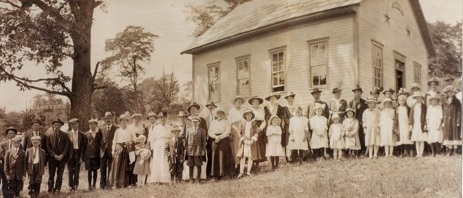 |
| Mt. Bethel Church, Paddytown, site of a controversial meeting, mid-1830s |
 |
Rev. J.F. Kuhlman |
While there is nothing more on the record about the Paddytown church debate, arguments continued over the decades about doctrine and practice. One of these was about the proper role of baptism for infants versus the free will baptism of a consenting adult. Many years later, on May 6, 1884, a conference of Lutherans gathered at Hooversville, with Rev. John Frederick Kuhlman among the participants. The proceedings were compiled and sent for publication to the various county newspapers. One of the paragraphs said that:
…the following subjects were discussed in well prepared and able papers: “Proper Subjects of Baptism,” by Rev. J.F. Kuhlman; “The Mode of Baptism,” by Rev. J.H. Zinn. It was conclusively shown that infants, as well as adult believers, are proper subjects of baptism, and that no particular mode is essential to the validly of the ordinance. This church question was thoroughly and impartially discussed, and the right of choice of Christian liberty fully allowed.
 |
Somerset Herald, May 19, 1875
|
The final reference in Vogel’s book to one of our cousins was the summer 1879 formation of a Somerset branch of the Christian Women’s Board of Missions. The group had 46 members, with the presidency held by Martha Knable, daughter of Major John and Mary “Polly” (Younkin) Knable. Vogel reports that “The exercises of these meetings are of a superior character; their essays especially are all worthy of publication.” The branch’s fund of $73.16 was higher than Allegheny County’s (Pittsburgh) and Philadelphia’s.
The Turkeyfoot church and our family were mentioned in an 1886 article in The Disciple: A Monthly Magazine of Christian Literature, as a preview of Vogel's book.
~ The End and What Remains Today ~
Sadly, the Christian Church in Turkeyfoot met its demise through attrition and lack of leadership and interest over the decades. Having purchased the from Henry Boucher, by 1875, the trustees decided to sell the meeting house and property. Their request was granted by the Court of Common Pleas on April 10, 1875.
The following month, on May 19, 1875, an advertisement was placed in the Somerset Herald, stating the trustees' intention lest anyone object. The ad was signed by the Schrocks' son Edward Morgan Schrock, Prothontary of the Court of Common Pleas. The trustees named at the time were Catharine Dwire, Elizabeth Boucher, A. Boucher, Aaron and Mary Schrock and David Younkin.
In about 1887, the building was sold to the German Baptist congregation, and over time it was also known as the Fairview Church of the Brethren. The log house was torn down about 1902, and was replaced by a frame structure. This newer church was remodeled in the late 1930s. It was torn down in about 1970, and the lot has been vacant ever since.
|
Above left and below: the Disciples' building in Somerset, corner of South Center Avenue and West Patriot Street, circa 1860-1900. Above right: the new building, 139 East Main Street, early 1900s.
|
 |
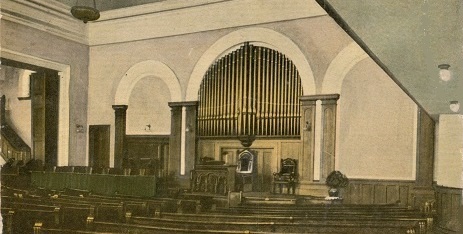 |
| Above: sanctuary of the Disciples church in Somerset |
|
|
Among the local residents who have helped maintain the cemetery over the years include the late Orville Brougher, Dutch Brougher and Harvey Shaffer. Ross A. Brougher cut grass there with a team of horses. In an interview in 1992, with the founder of this website, Orville said that the old log church was located closer to the woods that to where the frame church later stood. This website's founder also visited the site in July 1992 with Forrest Hall, an aged Kingwood resident who recalled hearing about the church as a boy.
This website's founder drew a map of the site which is found here. The inverted "U" shape on the map marks a turnaround for horses and buggies, and later automobiles. The turnaround path was dug down 6 or 7 inches and a stone base was laid in. The excavated earth was spread on the sloping ground near the tree line to level off the property. Before that, the ground was so bumpy that someone could not take a riding lawnmower over it.
The founder of the movement, Rev. Campbell, established Bethany College in Virginia (later West Virginia) in about 1840, which he used as a base of operations for educating future Disciples pastors and liberal arts students and publishing his newspaper, the Millennial Harbinger. For 26 years, until his death in 1866, he served as president, never receiving compensation for his administrative or teaching services. According to the college, he "paid his own traveling expenses, gave personal loans to students, paid faculty out of his own pocket, and funded much of the college’s construction."
In August 1847, Eli Minerd, youngest son of Jacob and Catherine (Younkin) Minerd, became orphaned at age 16. His mother's cousins Dr. Jonas Younkin and Aaron Schrock -- both leaders of the Turkeyfoot church -- were named as his legal guardians. At the demise of the Turkeyfoot congregation in the 1850s, and pursuing his own way, Eli relocated to Mount Pleasant, Westmoreland County, PA, where he was a longtime coke oven laborer and joined the Church of God. His son Rev. Isaac Herschel Minerd and grandson Dr. Roy Sheppard Minerd co-founded the Minerd-Miner Reunion in 1913 in Ohiopyle, Fayette County, PA, which was a forerunner to our national reunions of today.
|
Two views of Eli Minerd, above. Note the shaven upper lip, mirroring Alexander Campbell's style. Below, Eli's son, Rev. Isaac Herschel Minerd (circled), president of the inaugural Minerd Reunion at Ohiopyle PA in 1913. Click to enlarge.
|
 |
~ More About Disciples Founder Rev. Alexander Campbell
and His Long-Term Influence ~
Bethany College today is comprised of a campus of 1,300 acres providing education in a wide array of studies, with bachelor of science and bachelor of arts degrees awarded in more than 25 fields of study, with more than 10,000 living alumni. More on the college: www.bethanywv.edu/
Today, the Church of Christ is considered a mainline denomination in the Reformed tradition, with local churches governed by their congregations. National membership as of 2015 was 497,423 within some 3,267 individual congregations across the country. Its official website is http://disciples.org/.
|
Campbell's residence in Bethany, WV |
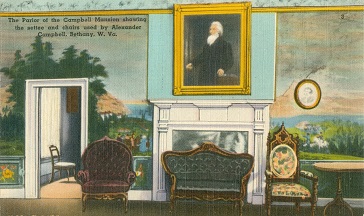 |
| Campbell's parlor, with his portrait and furniture used during his lifetime. |
 |
| Campbell's study building on the home farm |
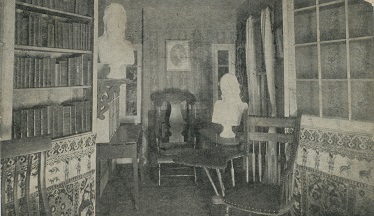 |
| Interior of Campbell's study |
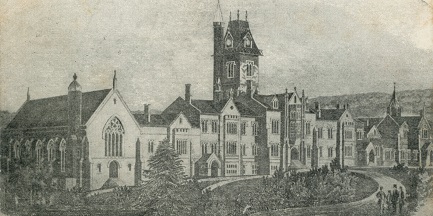 |
| Early view of the main building of Bethany College |
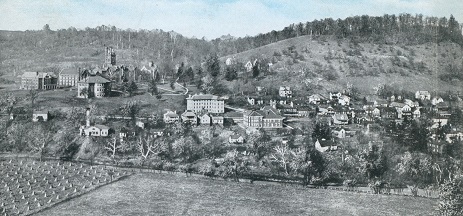 |
Bethany College (upper left), tucked into the West Virginia hillside |
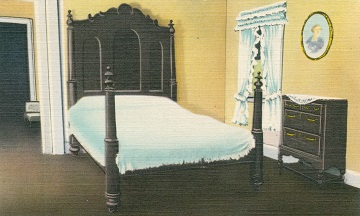 |
| The bed in which Campbell died at home |
 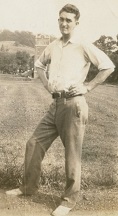 |
Odger Miner and Monalea Ullom (circled), grandparents of the founder of this website, taking summer classes at Bethany College circa 1927. |
|
Copyright © 2017, 2019 Mark A. Miner |


